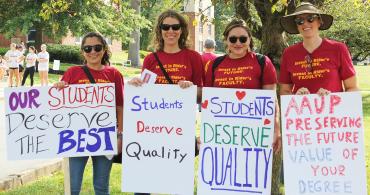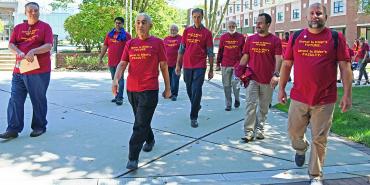It was a mighty battle.
On the one hand, university administrators at Rider University in Lawrence Township, N.J., threatened to dissolve the faculty union. On the other hand, faculty turned out in droves—the largest meeting ever, with more than 200 people in attendance—and voted overwhelmingly to strike.
Just as union leaders were drafting the strike announcement, management knocked on the door and the parties sat down for another three hours, hammering out an agreement that could set a precedent for collective bargaining at private universities across the country.
The right to a union
Members of the Rider University chapter of the American Association of University Professors/AFT have been fighting flat pay, increased healthcare costs and decreased benefits over the course of a monthslong contract negotiation. But while these issues were compelling, an even weightier one loomed. As one union organizer put it, administrators were threatening to “Yeshiva the unit.”
In other words: They were ready to dissolve the union.
The threat is based on the 1980 U.S. Supreme Court decision National Labor Relations Board v. Yeshiva University, which essentially refuses faculty at private universities the right to unionize. The opinion argues that faculty have management responsibilities and cannot be categorized as workers, so therefore cannot unionize. Public universities, which are governed by state policy, are not affected by Yeshiva, but the ruling has discouraged unionization at private universities for decades.
If Rider administrators had carried out their threat, they would have brought the union before the National Labor Relations Board and, based on the Yeshiva precedent, the NLRB would likely have ruled in the university’s favor.
RU-AAUP’s new agreement is groundbreaking: It prohibits the university from bringing a Yeshiva challenge to the NLRB for the next 10 years. This legally binding agreement is outlined in a side letter that accompanies the newly ratified contract.
Jeffrey Halpern, RU-AAUP’s chief negotiator, says he knows of no other union that has used a tool like this to protect itself, and he’s been negotiating union contracts for more than 40 years. “It guarantees our existence for 10 years and puts us in a much better situation at the next negotiation,” he says. And it could be a tool for other faculty unions to strengthen their positions as well.
A long fight
The negotiations that led to this unique solution and the associated contract ratification were the most difficult Halpern has ever experienced. “The administration seemed prepared to take steps that, in our judgement, would not only destroy the union but destroy the institution,” he says. “Our right to collective bargaining and viability as a union was at stake.”
With this sort of pressure, solidarity made a tremendous difference. Members—who include tenure-track, nontenure-track and adjunct faculty, lecturers, librarians and coaches—picketed the campus during move-in day with signs linking faculty working conditions with student learning conditions: “Quality faculty = quality education.” They marched into the convocation together wearing bold red T-shirts that said, “Invest in Rider’s FUTURE. Invest in Rider’s FACULTY.” Students, who picketed alongside them, were so enthusiastically supportive the union ran out of solidarity T-shirts for them.
The power demonstrated by these actions, plus the support of the national AAUP and AFT offices and AFT New Jersey, greatly influenced the outcome of the negotiations, says RU-AAUP Chapter President David Dewberry, who called it “indispensable in helping us create leverage to get a fair contract and create a deal that would protect our bargaining unit.”
In addition to the 10-year freeze on filing a Yeshiva case, the union shut down a proposed increase in faculty workload, saved tuition remission and won funds for scholarly activity. Pay concessions were painful—no increase for two years—but, says Halpern, “I believe this is the best contract that could be achieved without a strike.”
Strength in solidarity
The successful ratification is one of the first actions among AAUP-AFT locals since the AAUP and the AFT strengthened their affiliation last summer. “This partnership is game-changing for the promise and potential of higher education,” says AFT President Randi Weingarten. “Through this affiliation, we double down on the work to make colleges and universities excellent places to teach and learn, and to join forces to battle the ongoing threats to academic freedom and democracy.”
“Our affiliation went into effect on Aug. 1, and we’re seeing the fruits of it right now—a strong academic labor movement,” said AAUP President Irene Mulvey as she stood with Weingarten at the picket lines of the recent strike at Eastern Michigan University, another AAUP-AFT affiliate. That strike led to a strong contract ratified Sept. 23.
Back at Rider, union leaders are relieved their unit remains standing. But with Rider facing financial woes, the union faces more battles, says Halpern: Layoffs are highly possible and some departments could face serious cuts. “It’s nice to have a contract,” says Dewberry, “but if the finances are as bad as the administration has portrayed them, we still have room to be concerned for the future of Rider. We hope we get good leadership that can foster that and work toward that.”
With the sort of solidarity and power displayed during contract negotiations, leaders feel sure faculty will have a voice as the university moves forward.
[Virginia Myers]


